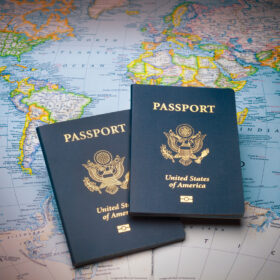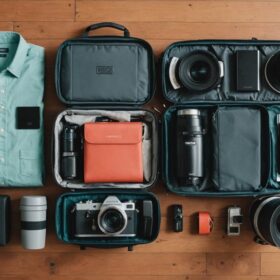How to Stay Connected Abroad With SIM or Esim Cards
Recent Blog
Ready to explore the world?
Post Tags
How to Stay Connected Abroad With SIM or Esim Cards
- Joseph Chanlatte
- Travel Tips
I recommend checking if your phone supports eSIM technology (iPhone XS and newer, Google Pixel 3 and newer, Samsung S20 and newer) since it’s super fast to set up and you don’t have to swap out physical cards. If your phone can use eSIM, I’d go with that to avoid extra charges, but if you have an older phone, you’re better off getting a regular local SIM card instead. Before you leave, set up your eSIM through your phone settings, figure out how much data you’ll need (if you’re just browsing the internet you need about 100-300 MB per day, but if you’re watching videos you’ll need 2-5 GB), and save maps on your phone so you have them even without internet. This guide tells you everything you need to know to stay connected when you’re traveling internationally.
Table of Contents
ToggleUnderstanding Esim Technology and Device Compatibility
eSIM technology is pretty cool because it’s different from regular SIM cards. With old SIM cards, you have to physically take them out and swap them whenever you travel to another country. But with eSIM, the SIM is built right into your phone, so you don’t have to do that.
I think it’s awesome because when I travel to different countries, I can just switch to a new carrier by using my phone instead of having to find a store that sells local SIM cards.
However, not all phones can use eSIM. You need a newer phone to use this technology. Your phone needs to be an iPhone XS or newer, a Google Pixel 3 or newer, a Samsung S20 or newer, or an iPad from 2020 or later.
So before you buy an eSIM plan, make sure your phone can actually use it. You should also ask your phone company if your phone needs to be unlocked first.
The good news is that eSIM is just as safe as regular SIM cards. Both types of SIM cards use special codes to protect your information, so your data stays secure when you’re traveling and using the internet in other countries.
Choosing Between Esims and Traditional SIM Cards
When you’re going on a trip to another country, you need to pick between an eSIM or a regular SIM card. I think eSIMs are better if your phone can use them, and they work right away, you don’t have to physically swap cards, and you can avoid extra charges for using your phone outside your home country while keeping your regular phone number.
But regular SIM cards still work great for older phones or places where eSIMs aren’t available yet. You should also think about SIM card locks; some phone companies lock their phones so you have to *unlock* them before you can use them with a different SIM card.
What you should choose depends on what your phone can do, how long your trip is, and whether you want to use two different phone numbers at the same time while you’re traveling.
Activating Your Esim or Local SIM for International Travel
Once you pick how you want to connect to the internet, you need to turn it on before or while you’re traveling. Setting up an eSIM is pretty easy, you just go into your phone’s settings or use an app from your provider. I recommend alosim and Holafly.
If you’re using a regular SIM card, just put it in your phone and do what the company tells you to do.
Here’s what you should do to make sure everything works:
- Turn on your eSIM before you leave home so you can fix any problems while you’re still there
- Check that your connection works right away after you turn it on so you know it’s actually working
- Keep your old SIM card safe in a case so you can use it again when you get home
You should also protect your SIM cards by adding a PIN code to both your regular SIM and your eSIM.
This stops other people from using your card without permission.
Estimating Your Data Needs and Selecting the Right Plan
After you turn on your connection, you need to figure out how much data you want to buy. How much data you use depends on if you’ll use Wi-Fi a lot or if you’ll use mobile data the whole time to avoid extra charges when you’re traveling.
| Activity | Daily Data Usage |
|---|---|
| Light browsing, messaging | 100-300 MB |
| Maps, social media, photos | 500 MB-1 GB |
| Streaming, video calls | 2-5 GB |
You should use aloSIM’s data calculator to figure out how much data you’ll need based on how long your trip is and what you’ll be doing. Buy a little more data than you think you’ll use, it really stinks to run out of data when you’re in another country. Most companies also let you buy more data later if you need it.
Combining Offline Tools With Mobile Connectivity
Even if you have a good data plan, you still need offline tools as a backup. I learned this helps me when my connection stops working or I’m in places with no service.
Here’s what I suggest:
- Download maps before you go – Apps like MAPS.me let you use navigation without the internet after you save the maps you need.
- Get Google Translate ready offline – Download language packs so you can understand and use other languages even when you don’t have Wi-Fi. Android – IOS
- Save important stuff – Take screenshots of your hotel bookings, addresses, and emergency phone numbers so you don’t panic if your phone loses service.
Using these two things together means you can stay connected when you have internet and still be okay when you don’t.
Frequently Asked Questions
Can I Keep My Home Phone Number While Using an Esim Abroad?
Yes, you can keep your home phone number when you use an eSIM while traveling outside the country. You don’t have to switch your number to a different carrier because an eSIM lets you use two phone numbers at the same time. Before you leave, just check with your phone company to make sure your service will work in the country you’re visiting. This way, you’ll have good phone service the whole time you’re away.
What Happens if I Lose My Phone With an Esim Activated?
Losing your phone is really bad. You should call your phone company right away to turn off the eSIM so no one can use it. Then when you get a new phone, you can put the eSIM back on it. Most phone companies save your eSIM information, so you can download it again on your new phone.
Are Esim Plans Refundable if I Don’t Use All the Data?
Different companies have different rules about refunds. Most of the time, if you don’t use all your data, you can’t get your money back. But some companies are cooler about it and let you save your leftover data for next time instead of losing it. So make sure you read what each company says before you buy their plan so you don’t get surprised later.
Do All Countries Support Esim Technology and Local Coverage?
Want to stay connected everywhere you go? Here’s the thing: not every country supports eSIM technology yet. Different places around the world adopt new tech at different speeds. This means some countries are ready for eSIM, while others aren’t there yet.
Before you travel somewhere, you should definitely check if that country supports eSIM. Some regions still only use the old-fashioned physical SIM cards that you have to put into your phone. If you don’t check ahead of time, you might get stuck without a way to connect.
The bottom line is that global coverage with eSIM isn’t quite a thing yet, but it’s getting better. Always do your homework before your trip to make sure you’ll have a way to use your phone where you’re going.
How Do I Troubleshoot if My Esim Won’t Activate Properly?
First, make sure your phone can actually use eSIM with your carrier. Then turn your phone off and back on again. Check if there are any software updates you need to download. If the eSIM still won’t work, call or message your eSIM provider’s support team and they can help you figure out what’s wrong.
If you do these things, you won’t get any bad surprises and you’ll stay connected the whole time you’re traveling.
Travel is one of the best gifts I’ve ever given myself, and I want others to experience that same magic. If you’re a travel enthusiast, the faveplus travel site is an all-in-one guide packed with real, actionable steps to help you get out there and explore the world.










